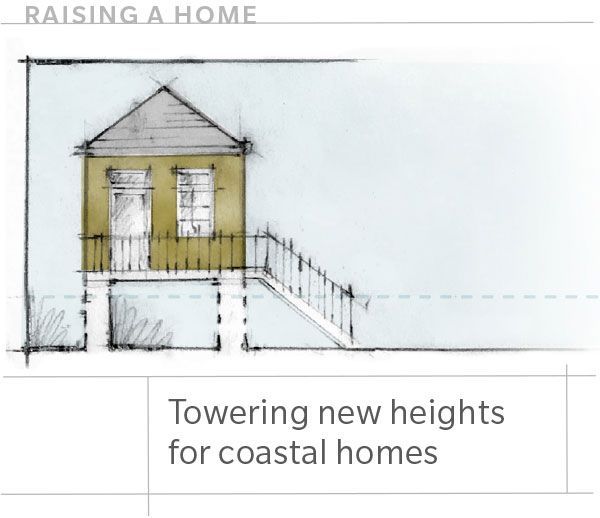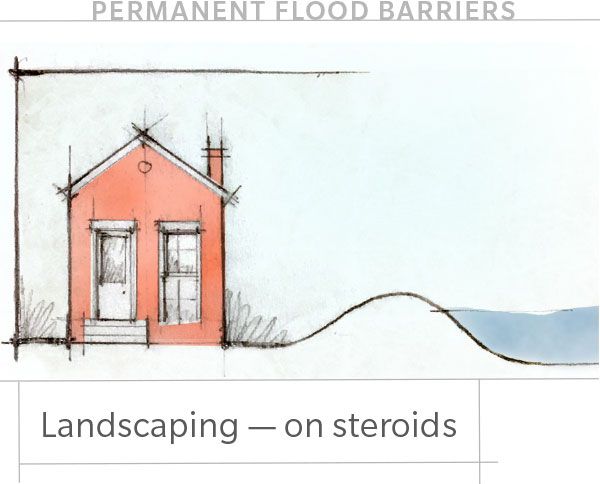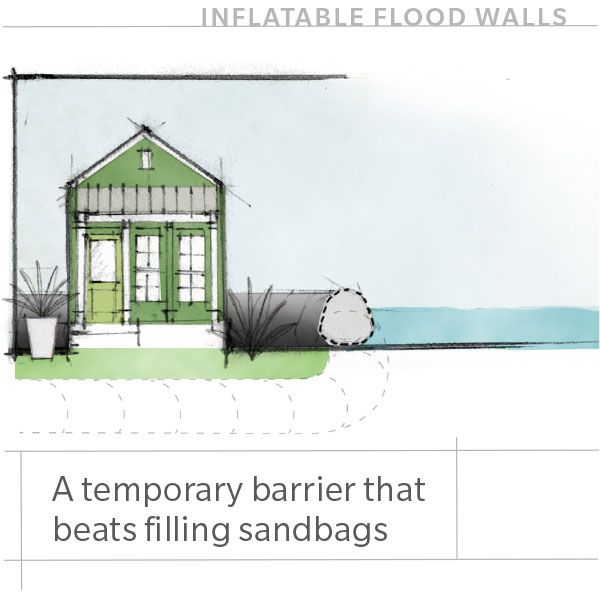"We thought we might need to elevate the house, but never imagined it would be 11 feet."
—Andrew Rosenman
When Superstorm Sandy plowed up the Eastern Seaboard in 2012, it left Andrew Rosenman’s summer home in Atlantic Highlands, New Jersey, in ruins.
“It looked like a bomb had exploded. The flood line on the wall of our house was at 52 inches high, and floodwaters ruined everything inside,” Rosenman says. “I knew it was bad when the Weather Channel parked its truck a block away and broadcast there for days.”
Every year, more than 90 percent of disaster-related property damage ($23.7 billion from 2017 to 2019) in the United States is caused by floods, according to the Federal Emergency Management Agency. Like the thousands of other homeowners whose houses have been destroyed by flooding, Rosenman and his wife had two choices: pack up and move on, or stay and rebuild to withstand the next flood.
They chose to stay.
That marked the beginning of a rebuilding odyssey for the Rosenmans, who are among the estimated 41 million Americans who live in a 100-year flood zone. For homeowners living in these areas, rebuilding higher or retrofitting homes to withstand more frequent flooding is the new reality.


A 100-year flood is an extreme flooding event that has a one percent chance of occurring in any year.
The Rosenmans’ house was originally set on cinderblock (which formed a narrow crawl space underneath), and water inundated the home during the storm. The couple knew a significant renovation would be required to make the home habitable again. What they didn’t anticipate: a yearlong wait before they could start work and a change in building codes that required raising the home 11 feet.
Physically elevating a home can be the most effective method to reduce the risk of flood damage, but it can also be the most expensive. For some homeowners in flood hazard areas, raising — or abandoning — their home may be their only choices. To qualify for flood insurance backed by F E M A’s National Flood Insurance Program, construction and repairs to seriously damaged homes in flood zones must comply with federal, state and local building codes, which may change in the aftermath of a flood disaster.
“Fixing the flood damage was an undertaking, but that alone would have been relatively simple,” says Rosenman. “We had to wait more than a year for F E M A and Atlantic Highlands to update building codes before we could start renovating.”
In Atlantic Highlands, all new buildings or buildings damaged by Sandy would need to be raised to the new Base Flood Elevation — the height of flooding that might be expected in a 100-year flood. To comply with new building codes, Rosenman had to build a concrete slab foundation and raise the house 11 feet.
In hindsight, Rosenman is grateful he and his wife waited 13 months before starting to rebuild. “Some of my neighbors rebuilt before F E M A issued its new B F E advisory for the area. Houses rebuilt below the new B F E wound up being ineligible for discounted flood insurance.”
The Rosenmans’ home was well suited for raising because of its simple, rectangular shape, size (1,100 square feet) and construction (wood frame, single story). His general contractor hired a company to detach the house from its foundation, then raise it on hydraulic jacks. While perched on the jacks, masons built an 11-foot, closed cinderblock foundation wall around the perimeter of the new slab. Flood vents near the bottom of the wall allow floodwater to flow under the house instead of building water pressure around the wall, which could cause it to collapse.
He estimates the entire project cost about $100,000: $20,000 to lift, $30,000 for the masonry, $40,000 for new electrical and plumbing, and roughly $10,000 for new appliances. The space beneath the house is now a garage — a small perk for the price, but one Rosenman appreciates.
Lift |
$20, 000 |
Masonry |
$30,000 |
Electrical and Plumbing |
$40,000 |
Applicances (estimate) |
$10,000 |
Total |
$100,000 |
The Rosenmans’ home is one-quarter mile from the New Jersey shoreline. In areas closer to the coast, or in homes at higher risk of flooding from waves or heavy, fast-moving floodwaters, continuous foundation walls like the Rosenmans’ could collapse. For these conditions, a home-owner may consider putting a home on stilts — vertical, steel-reinforced piers, posts, columns or pilings installed underneath the home at key support points, allowing water to flow freely underneath the home. (Local building codes, the structure type and flooding conditions will affect the style of elevation retrofitting. To learn more about elevating a home, see F E M A’s Homeowner’s Guide to Retrofitting.)

Local Help
The Association of State Floodplain Managers website lists local floodplain managers who can provide information about updated building codes that may affect flood retrofitting.
In 2000, landscape architect Shawn Anderson received an unusual call from a homeowner who lived across the street from the Lafayette River in Norfolk, Virginia. “He explained that even during a normal or slightly above-average high tide, water would pool in his front yard, which was annoying.” Then a nor’easter flooded his house and ruined the duct work underneath it, and the homeowner decided he’d had enough.
Selling the home wasn’t an option; he loved the views of the river and was willing to spend the money to keep his home safe from flood damage. But raising the Tudor-style house would ruin the aesthetic. The homeowner had an idea for building a berm. Anderson told him it would be a major, expensive undertaking, and that he’d never built anything like it.
Whether for structural reasons or aesthetic considerations, some homes aren’t great candidates for elevating, but building permanent barriers, such as levees and floodwalls, may help reduce the risk of flood damage. Levees are compacted earthen structures; flood walls are typically made of concrete or masonry. The berm Anderson eventually designed was a combination of both.
For stability and ease of maintenance, Anderson wanted a 3-to-1 slope on the berm: for every 1 foot built up, the berm would slope out 3 feet. And with a height of 4 feet, Anderson realized the entire front yard would be berm. His solution: build a barrier that is berm on one side and a retaining wall on the other, essentially cutting its width in half. The berm was high enough to offer protection, but not so high that it obscured river views.
"I’m looking out my front window and I see the water is coming up, but it’s not cresting over the berm — it’s doing beautifully."
— Virginia homeowner
Anderson also redesigned landscaping so that the berm and retaining wall would blend with the yard, adding a paver path that led up a landscaped hill with steps leading down the 4-foot wall into a sunken garden. The berm side was planted with various grasses and bushes that help prevent erosion, and thick ivy draped over the wall into the garden.
In 2003, Hurricane Irene revealed another problem. “During the storm, the homeowner called and said, ‘I’m looking out my front window and I see the water is coming up, but it’s not cresting over the berm — it’s doing beautifully.’” Unfortunately, water was coming in through the alley in back of his house. Anderson hadn’t anticipated a storm that would push water to that height.
After the storm, Anderson enclosed the loop in the back, essentially encircling the house with the berm and flipping the design so the back berm sloped up and away from the house.
The complete, custom-designed, 140-foot-long berm required more than 30 truckloads of dirt and included drainage systems, generator-powered pumps, custom-built retaining walls and concrete footers. Each section (at the front and back side of the house) took about one month to build and cost approximately $150,000, Anderson says.
Berm
A flat strip of land, raised bank or terrace bordering a river or canal.

Kenneth Page’s home was one of the estimated 146,000 damaged in 2016 when south Louisiana flooded. “We got hit by what people called a 500-year storm. We had a foot of water in the house,” he recalls. Elevating his brick home, which sits on a slab foundation, would have been a logistical nightmare and cost-prohibitive. Inspired by a viral video, Page bought a temporary, inflatable dam instead.
These types of barriers are typically designed to protect large residential, public or commercial properties. But for homeowners living inland or near rivers — far from coastal storm surges — waterfilled “cofferdams” may offer a measure of protection to reduce the risk of flood damage. These barriers are not recommended for coastal areas because they are filled with fresh water, which will float in dense sea water.
Page’s dam is 250 feet long and 30 inches high, weighs about 500 pounds unfilled, and can be filled with water in about 90 minutes. (Most homes may only require a 75 to 100 foot long dam, which weighs approximately 2 pounds per foot, according to one manufacturer.) The dam consists of a large outer tube encasing two inner tubes that fill with water. Hydraulic pressure between the inner tubes and the outer tube, along with the weight of the water, creates pressure that stabilizes the dam and keeps it from rolling away. Page has deployed the dam three times. “It definitely protected our house.”
We got hit by what people call a 500-year storm. We had a food of water in the house.

“There’s a little seepage, but the weight makes it nearly watertight,” says Page, who also purchased the optional gas powered pump and suction hose to divert water that breaches the dam.
Filling the dam before a storm and emptying it afterward is awkward and tricky, he says. “But, with practice, it gets easier.” The dams can be filled by a regular water hose, which takes more time, or a nearby water source, such as a pool or pond. Homeowners may also access water from a fire hydrant, with permission from the local water authority.
Pricing for inflatable dams varies based on the manufacturer, but one manufacturer charges $28 per foot, which does not include optional accessories, such as a water pump or hose. Page stores the 250 foot dam, with gas pump and suction hose, in a 3 by 4 by 8-foot box he built in the backyard. “All in, we spent about $6,000. Raising our house would have cost at least $50,000.”
Five years after Superstorm Sandy, the repairs to the Rosenmans’ summer home were completed. Looking back, Andrew Rosenman wishes he’d done things differently ahead of the storm. In the slow process of rebuilding, he learned he could have purchased N F I P’s Increased Cost of Compliance Coverage, which gives homeowners up to $30,000 as an incentive to raise homes before the flood.
I C C coverage can also be applied to relocating, demolishing or dry floodproofing. “The incentives for these activities would be lower insurance premiums, as their risk is reduced,” says F E M A’s Peter Herrick, Jr. “Homeowners should talk to their flood insurance agent to get a better idea of how it will impact their rates and what actions are the best for them.”
“Lifting my house cost more than $30,000,” says Rosenman. “But the $30,000 is there, insurance rates go down, and it’s definitely cheaper and easier to elevate your home before a flood comes. I wish I’d done it.”
Written by
The information contained in this page is provided for general informational purposes only. The information is provided by Farmers® and while we endeavor to keep the information up to date and correct, we make no representations or warranties of any kind, express or implied, about the completeness, accuracy, reliability, suitability or availability with respect to this article or the information, products, services or related graphics, if any, contained in this article for any purpose. The information is not meant as professional or expert advice, and any reliance you place on such information is therefore strictly at your own risk.
Related articles



